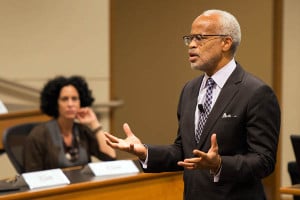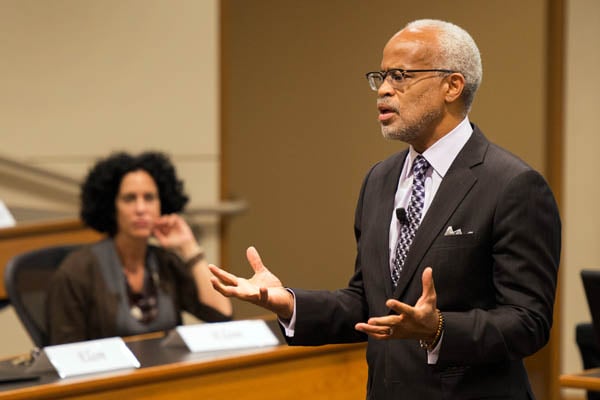
The Faculty Senate heard a report at its Nov. 8 meeting about how the University is working to implement the changes to undergraduate education suggested by the Study of Undergraduate Education at Stanford (SUES), which was approved by the Senate in May.
President John Hennessy opened the meeting by briefly noting the recent selection of Stanford alum Peter Salovey ’80 M.A. ’80 as President of Yale University.
Vice Provost of Undergraduate Education Harry Elam then began his report, stating that his office is working to pare down the SUES committee’s 55 recommendations. Elam identified efforts to integrate majors within a broader education, as well as integrating classroom study into students’ residential experience.
“Looking at the Stanford journey that students go on, I can [break] it down to three words – integrate, innovate and inspire,” Elam said.
The emphasis on innovation, Elam noted, has already been explored substantially at Stanford, with concepts such as the flipped classroom and an increased emphasis on project-based learning. He said such efforts should be further encouraged.
“There are amazing things that faculty are doing already,” Elam said.
Elam also reminded the Senate of the broader significance of a Stanford education in providing students with the tools to make a difference in the outside world.
“We want to inspire students to find their own Stanford,” Elam said. “We want them to be empowered…to really find their own path.”
“We want to deliver an education that’s vital and enduring,” he added, acknowledging student concerns about a perceived lack of vocational content. “We have to be concerned about these things.”
Turning his attention to Thinking Matters, the freshman requirement that replaced IHUM this academic year, Elam cited the breadth and number of courses offered as a significant success. He noted that 88 percent of freshmen were selected for their first-choice Thinking Matters course, and 54 percent of incoming freshmen said they intended to take more than one.
While the Faculty Senate decided last May to not make freshmen introductory seminars mandatory, Elam noted that seminars have enjoyed a rise in popularity over previous years, with 91.5 percent of incoming freshmen planning to take at least one. Elam credited the program’s voluntary nature as a contributor to its success.
He acknowledged, however, that scheduling conflicts and required application statements might preclude greater involvement in seminars by athletes and students from under-resourced backgrounds, respectively.
“We have to work with both these groups to allow more flexibility and make them feel that that’s not a hurdle to getting into seminars,” Elam said.
Elam also briefly applauded the Cardinal Compass portal – an online tool offering guidance in course selection – as a success in channeling curious freshmen into appropriate classes, though he noted that the portal’s offerings could be further expanded.
“There a real sense that this device has worked,” Elam said.
Looking to future reforms, Elam highlighted the potential benefits of helix courses – sequences of classes built around an overarching topic – and “capstone” projects offering students a means of effectively summing up their Stanford experience.
“We want to offer interdisciplinary synthesis,” Elam said. “What this has the potential to be is something that’s uniquely Stanford.”
According to Elam, his office will soon send out a survey to faculty that will examine topics like teaching practices and the relationship between scholarship and classroom teaching.
“This is an exciting moment here at Stanford to take advantage of,” Elam said.
A brief discussion period largely focused on the reforms’ implications for methods of education and feedback that might be solicited from students.
Gabriella Safran, professor of Slavic languages and literatures, applauded the general shift towards a “capacity – rather than content – based” method of education, but wondered if the shift would create tensions among faculty members weighing the two approaches.
“It’s going to take time,” Elam said. “It’s going to take adjustment. It’s something that faculty are going to have to find their own way in.”
Susan Holmes, professor of statistics, questioned the wisdom of soliciting student feedback in course evaluations conducted at the end of the quarter, calling for a more long-term view.
“That’s like evaluating the dentist right after you’ve gotten out of the dentist’s chair,” Holmes said.
Caroline Hoxby, professor of economics, argued that despite offerings like Cardinal Compass, freshmen students still tend to take either broadly subscribed introductory offerings or highly specific classes geared towards older students.
“Most of the freshmen don’t have a very good understanding of all the different fields,” Hoxby said. “They appear to choose them kind of idiosyncratically. It would be good to help freshmen think about the fact that a good course for freshmen is one that helps them explore.”
